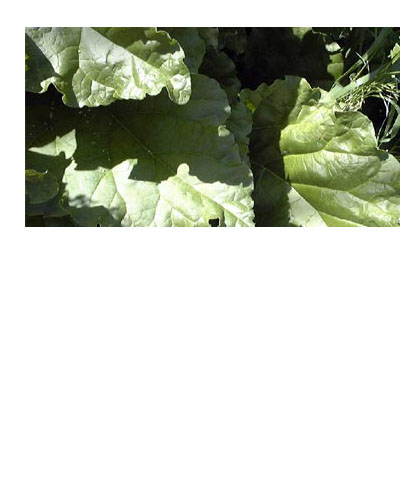Rewand Chini
Latin: Rheum Emodi
Therapeutic Action:
Rhubarb has a long and proven history of herbal usage, its main effect being a positive and balancing effect upon the whole digestive system. It is one of the most widely used herbs in Chinese medicine[238]. The main species used is R. palmatum. Though the chemistry varies slightly, this species is used interchangeably[238]. The root is anticholesterolemic, antiseptic, antispasmodic, antitumor, aperient, astringent, cholagogue, demulcent, diuretic, laxative, purgative, stomachic and tonic[4, 37, 57, 61, 171, 238, 240]. Small doses act as an astringent tonic to the digestive system, whilst larger doses act as a mild laxative[232]. The root is taken internally in the treatment of chronic constipation, diarrhoea, liver and gall bladder complaints, haemorrhoids, menstrual problems and skin eruptions due to an accumulation of toxins[238]. This remedy is not prescribed for pregnant or lactating women, nor for patients with intestinal obstruction[238]. Externally, the root is used in the treatment of burns[238]. The roots are harvested in October from plants that are at least six years old, they are then dried for later use[4]. A homeopathic remedy is prepared from the dried root[232]. This is used especially in the treatment of diarrhoea in teething children[232]. Remedies For: Purgative, alterative, hemostatic, antipyretic, anthelmintic, stomachic, bitter tonic, cathartic, laxative, atonic indigestion Constipation (with fevers, ulcers, infections), diarrhea, Pitta dysentery, jaundice, liver disorders. Rhubarb Root has a purgative action for use in the treatment of constipation, but also has an astringent effect following this. It therefore has a truly cleansing action upon the gut, removing debris and then astringing with antiseptic properties as well. Note: Rhubarb Root may color the urine yellow or red. Small doses - tonic hepatic. Large doses - cathartic. Ayurvedic Applications Rhubarb is stomachic, bitter, tonic, cathartic. Useful for simple diarrhea, but not in constipation or any affection in which a continuous aperient action is necessary; Its stimulating combined with its aperient properties render it valuable in atonic dyspepsia. Best used for the ailments of children and aged persons. Combined with ginger, it may be given in the form of pill in cases where the bowels are sluggish. Ordinary dose of the powder is from 5 to 20 grains. Some persons chew the root. Rhubarb is an important ingredient of a large variety of herbal compounds. Mixed with Grey Powder it is an excellent remedy for irritation of the bowels, common among children when teething and in chronic dysentery, duodenal catarrh or catarrh of the biliary ducts with jaundice and in certain skin diseases. As a mild purgative, rhubarb protects colon tone, used with licorice and psyllium in older and dryer persons (ginger or fennel is added to remove griping action-4 parts rhubarb: 1 part ginger or fennel); purges bile, ama, stagnant food and blood; reduces weight and fat. It is stronger when used with epsom salt. Traditional Chinese Herbalism Applications: Purgative, antibacterial, antitumor, antifungal, diuretic, hemostatic, cholagogue, antihypertensive, lowers serum cholesterol, anti-inflammatory Rhubarb is one of the more powerful herbs used in Chinese medicine. It is excellent for draining damp heat, especially when there is accompanying constipation. It moves the blood and is good for blood stagnation associated with acute stabbing pain and bruises, for which it can be taken both internally as well as externally in a liniment. Useful for dysenteric conditions caused by damp heat with symptoms of bleeding in the stool. It can also be taken for vomiting of blood. It can be used both internally and topically for infections. It kills blood flukes. As an external remedy for inflammatory skin conditions such as boils and bums, rhubarb powder can be used alone or combined with other herbs with a little flour and water or honey to hold it together. Combinations : It should be combined with carminative herbs to relieve any griping that may occur. The root are astringent, tonic and purgative .the tuber is pungent, bitter, alexiteric, emmenagogue , diuretic ;reported to be useful in biliousness, chronic bronchitis asthma, sore eyes and bruises.
References:
- Nadkarni, Vol I. Pages 1056-1058
- Duke's, Page 404
- Leung & Foster Pages 436- 440
Used in:
- Fluton Tablets
- Livonex Tablets
- Violax Tablets
- Citazil Syrup
- Livonex Syrup / Livonex Drops

Copyright 2013 Unexo Laboratories Pvt. Ltd. All Rights Reserved. Designed & Developed By: Credence Technologies


